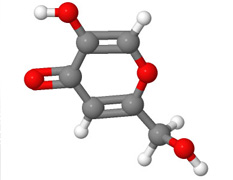







Kojic acid molecule
Introduction
Kojic acid (5-hydoxy-4-pyran-4-one-2-methyl) is a fungal metabolite derived from various fungal species such as Acetobacter, Aspergillus, and Penicillium that is chemically related to hydroquinone and acts as a tyrosinase inhibitor.
Mechanism of Action
It functions by chelating copper at the active site of the tyrosinase enzyme. It also acts as an antioxidant and prevents the conversion of the o-quinone to DL-DOPA and dopamine to its corresponding melanin. Melanocytes that are treated with kojic acid become nondendritic and have decreased melanin content. Kojic acid also acts as a free radical scavenger.
Studies
In one study, kojic acid was reported to have a high-sensitizing potential and to potentially cause irritant contact dermatitis. However, it is useful in patients who cannot tolerate hydroquinone and it may be combined with a topical corticosteroid to reduce irritation. Kojic acid also inhibits the catecholase activity of tyrosinase, which is the rate-limiting, essential enzyme in the biosynthesis of the skin pigment, melanin. Moon et al. (2001) discovered that the activation of NF-kappaB induced by kojic acid, an inhibitor of tyrosinase for the biosynthesis of melanin in melanocytes, was investigated in human transfectant HaCaT and SCC-13 cells. Their results indicate that kojic acid is a potential inhibitor of NF-kappaB activation in human keratinocytes, and they hypothesize that the inhibition of NF-kappaB activation may be involved in the kojic acid induced anti-melanogenic effect.
Kojic Acid Derivatives
Recently, some stable kojic acid derivatives had been synthesized for better penetration through the skin. The most important ones were those synthesized by joining two pyrone rings through an ethylene linkage, and kojyl-APPA (5-(3-aminopropyl)-phosphino-oxy-2- (hydroxymethyl)-4H-1-pyran-4-one) was tested in melanoma cells and normal human melanocytes. A distinct, more stable derivative of kojic acid synthesized by Kim et al., 5-[(3-aminopropyl)phosphinooxy]-2-(hydroxymethyl)-4H-pyran-4-one (Kojyl-APPA), showed increased skin penetration and pigment lightening efficacy in melanoma and normal human melanocytes.
Formulations
KA is used in a 1-4% cream base, either alone or in combination with hydroquinone, tretinoin or a corticosteroid. It appears that KA acts synergistically with glycolic acid. The addition of a 2% KA in a gel containing 10% glycolic acid and 2% hydroquinone showed superior results compared to the same gel without KA in one study. Multiple other studies including Caucasian and Asian patients have shown that combination therapy with 2% KA and hydroquinone improves results. In a study comparing glycolic acid/kojic acid combination with glycolic acid/hydroquinone, no statistical difference in efficacy was reported between kojic acid and hydroquinone; however, the kojic acid preparation was reported to be more irritating. To decrease the irritation from kojic acid, it is combined with a topical corticosteroid. In a comparison study, 2% hydroquinone, 10% glycolic acid, and 2% kojic acid decreased hyperpigmentation in patients with melasma better than the same combination without kojic acid.
Safety
Kojic acid had been found to cause allergic reactions, and it showed only modest effectiveness in clinic trials. Multiple clinical studies have demonstrated its increased sensitizing potential. It is associated with sensitization, contact dermatitis and erythema.
>
>
>
>
>
>
>
>
>
>
>
>
>
>
>
>
>
>
>
>
>
>
>
>
>
>
>
>
>
>
>
>
>
>
>
>
>
>
>
>
>
>
>
>
>
>
>
>
>
>
>
TOP 20
Hydroquinone
Monobenzyl Ether of Hydroquinone
Azelaic Acid
Kojic Acid
Arbutin
Retinoids
Mequinol
Niacinamide
Soy
Vitamin C
Corticosteroids
Licorice
Hydroxystilbene
Aloesin
Glutathione
Glycolic Acid
N Acetyl Glucosamine
Gentisic Acid
Green Tea
Melatonin
SKIN WHITENING AGENTS A-Z
a-Hydroxyacids
Aloesin
Alpha Tocopherol and Alpha Tocopherol Ferulate
Arbutin
Azelaic Acid
Centaureidin and Methylophiopogonanone B
Gallic Acid and Derivatives
Gingko
Ginseng
Glutathione
Glycolic Acid
Green Tea
Hesperidin
Hydroquinone
Hydroxycinnamic Acid and Derivatives
Hydroxystilbene
Kojic Acid
Licorice
Linoleic Acid
Magnesium Ascorbyl Phosphate
Melatonin
Mequinol
Monobenzyl Ether of Hydroquinone
Mulberry
N Acetyl Glucosamine
N-Acetyl-4-S-Cysteminylphenol
Niacinamide
Retinoids
Salicylic Acid
Soy
Vitamin C

<< Previous: Azelaic Acid
Next: Arbutin >>